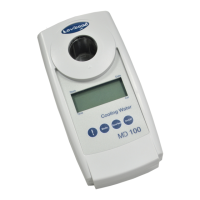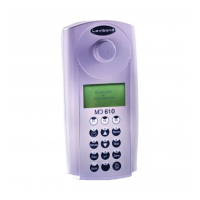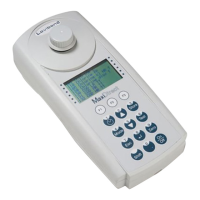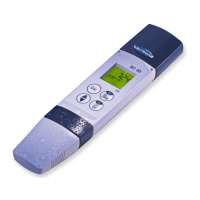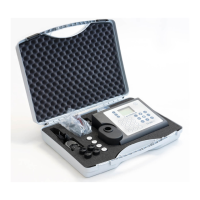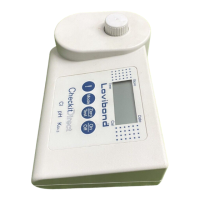GB
Methods
Notes:
1. Vial cleaning:
As many household cleaners (e.g. dishwasher detergent) contain reducing substances,
the subsequent determination of Chlorine may show lower results. To avoid any meas-
urement errors, only use glassware free of Chlorine demand.
Preparation: Put all applicable glassware into Sodium hypochlorite solution (0.1 g/l) for
one hour, then rinse all glassware thoroughly with deionised water.
2. For individual testing of free and total Chlorine, the use of different sets of glassware is
recommended (EN ISO 7393-2, 5.3)
3. Preparing the sample:
When preparing the sample, the lost of Chlorine, e.g. by pipetting or shaking, must be
avoided. The analysis must take place immediately after taking the sample.
4. The DPD colour development is carried out at a pH value of 6.2 to 6.5. The reagents
therefore contain a buffer for the pH adjustment.
Strong alkaline or acidic water samples must be adjusted between pH 6 and pH 7 before
the reagent is added (use 0.5 mol/l Sulfuric acid resp. 1 mol/l Sodium hydroxide).
5. Exceeding the measuring range:
Concentrations above 10 mg/l Chlorine can lead to results showing 0 mg/l. In this case,
the water sample must be diluted with water free of Chlorine and the measurement
repeated.
6. Turbidity (can lead to errors):
The use of the DPD No. 1 tablet in samples with high Calcium ion contents* and/or high
conductivity* can lead to turbidity of the sample and therefore incorrect measurements.
In this case, the reagent tablet DPD No. 1 High Calcium should be used as an alternative.
If turbidity does occur after the DPD No. 3 tablet has been added, this can be prevented
by using the DPD No. 1 High Calcium tablet and the DPD No. 3 High Calcium tablet.
The DPD No. 1 High Calcium should only be used in combination with the DPD No. 3
High Calcium.
* it is not possible to give exact values, because the development of turbidity depends
on the nature of the sample.
7. Oxidising agents such as Bromine, Ozone etc. interfere as they react in the same way as
Chlorine.
Reagent Form of reagent/Quantity Order-No.
Set
DPD No. 1 / No. 3
Tablet / per 100
inclusive stirring rod
517711BT
DPD No. 1 Tablet / 100 511050BT
DPD No. 3 Tablet / 100 511080BT
Set
DPD No. 1 HIGH CALCIUM /
DPD No. 3 HIGH CALCIUM
Tablet / per 100
inclusive stirring rod
517781BT
DPD No. 1 HIGH CALCIUM Tablet / 100 515740BT
DPD No. 3 HIGH CALCIUM Tablet / 100 515730BT
